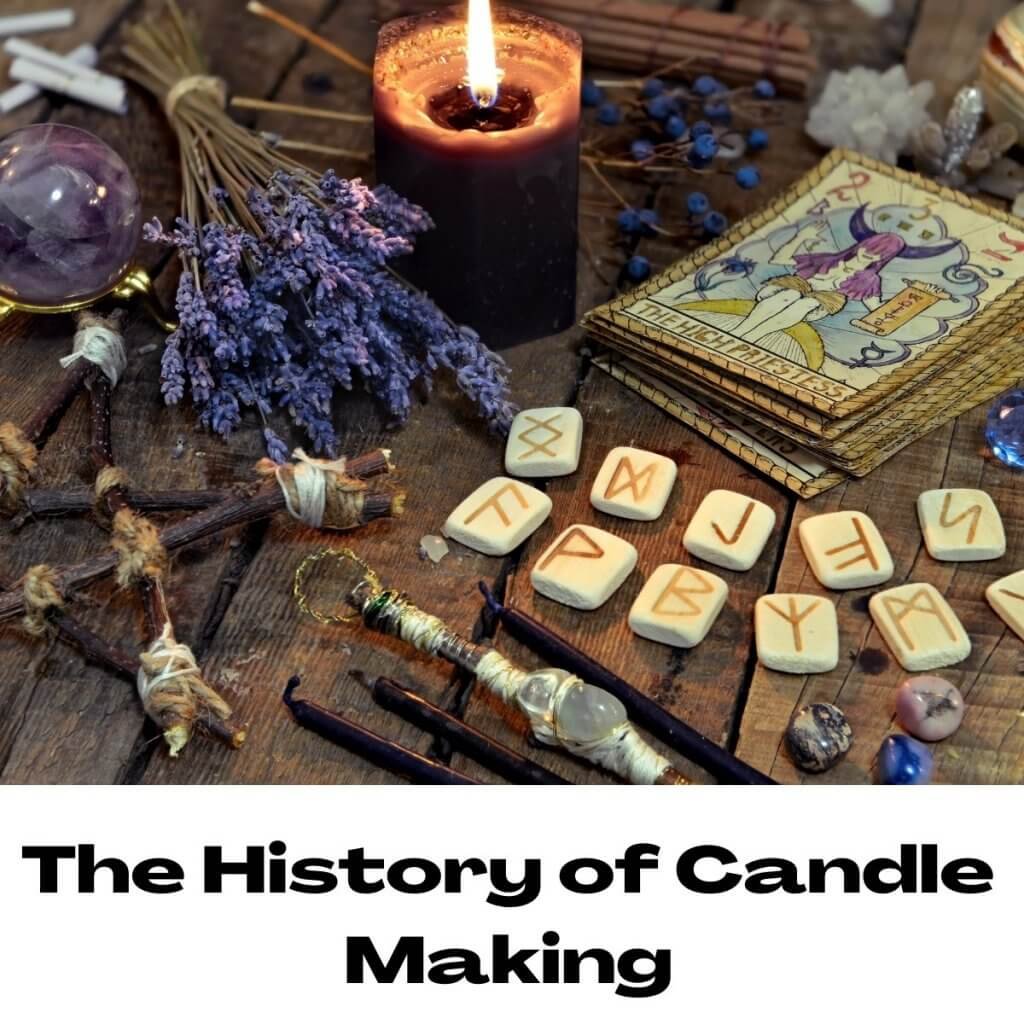What is Candle Making?
This week we will introduce you to candle-making for beginners. Candle making is the craft of creating candles from scratch. It is both an art and a science as a lot of thought goes into selecting the right ingredients.
This activity has become increasingly popular in the past decade due to the rise of artisanal handicrafts. More and more people enjoy the idea of being able to select their own ingredients and creating products from start to end.
Making candles is a great craft to explore as you can experiment with a lot of different ingredients. You will need to select the right wick and wax to fit the style of candle you desire.

Fragrances, dyes, and other items can be added as well. Candle making is highly customizable and allows a lot of room for creativity!
Candles would make a perfect gift for friends and family members, especially around the holidays if you wanted to give a thoughtful, homemade present.
Candlemakers can also sell their creations at artisanal fairs, craft expos and online marketplaces like Etsy.
Perfect Hobby For You:
The history of candle making
Candles can be traced back as early as 3000 BC based on a discovery of a bronze candleholder in Ancient Egypt.
The Chinese and Romans are also speculated to have made the first candle. Although there is no clear historical record for its creation, there is evidence for its inception in different countries worldwide.

Who Made the First Candle?
Egypt – Egyptians used “rushlights” as an early form of the candle. Rushlights were created using a piece of rush plant dipped in tallow (animal fat). They most likely used rolled papyrus as the wick. These candles were speculated to be quite soft and melted easily under the hot sun.
East Asia – The Chinese also used papers as wicks but used insect or seed oil for the wax. The Japanese further evolved this form of the candle and used oils extracted from tree nuts as their base. In India, the candles were created with the oils of cinnamon fruit.
Europe – The first candle fragment was actually found in France. It was hypothesized to be from the first century. Historical records have definitively documented candle usage during the Middle Ages, which were utilized for exterior and interior lighting.
The Evolution of Candle Wax
Candles took on their own form based on the region, varying in the type of wick and wax used. People would use oils from plants, fruits, nuts, and animals.
Animal fats, or tallow, used in the past were commonly sourced from cows, pigs, and sheep. As you can probably imagine, candles made from tallow didn’t smell as pleasant as the candles we have today.
Up until the 18th century, tallow was the primary wax used for candles. When the whaling industry became popular, people started to use spermaceti wax made from the head oil of a sperm whale.
This type of wax emitted a more pleasant odor than animal fats and burned quite cleanly. Once stearin and paraffin wax were developed, the use of spermaceti wax faded. By the end of the 20th century, soy, palm, and synthetic waxes entered the market.
The Decline of candle making
With the invention of the candle-making machine in the early 19th century, the manual process of traditional candle-making started to decline.
Machines could produce thousands of candles per hour, way more than any solo candlemaker could keep up with. Due to this, candles have become much more affordable and available on the market.
A drop in candle making was seen again with electricity’s invention by the end of the 19th century. Candles were then only used for emergency purposes and special occasions.
The Rise of Candle Making
Although lightbulbs are the primary source of lighting now, candles create an ambiance that cannot be achieved with modern bulbs. Popularity for candles reignited by the end of the 20th century.
Per the National Candle Association, candle manufacturing is now more than a $3 billion industry with an estimated 1 billion pound of wax being used annually to produce candles sold in the United States.
The popularity of handcrafted goods in recent years has skyrocketed with candles being a favorite item to make among hobbyists.
Affordable supplies have allowed homemakers to create their own candles and even start their own businesses selling these artisanal gifts.
Different Types of Candles
There are several different varieties of candles that you can make. You will need to choose the correct wick and wax based on the type you’d like to create. Not all wicks and waxes will work the way you need them to based on the type of candle.

- Tealights – Tealights are small, short candles in a small plastic or aluminum container. They are usually less than an inch high and 1.5 inches wide in diameter. You can also put these tealights in larger containers to create a more elegant look. Paraffin or soy wax works well for tealights.
- Votives are also small, cylindrical candles but a little bit taller than tealights. They usually stand at about 2-3 inches tall, with a diameter of about 1.5 inches wide. Votive candles are free-standing but can be placed in glass containers to hold the melted wax while it is burning.
- Pillars – Pillars are thick, firm cylindrical candles that can be free-standing or placed in hurricane containers. They generally have a diameter of two inches or more and come in various heights. It’s essential to be attentive to the time you keep a pillar candle burning. If you have a 2-inch diameter candle, avoid letting it burn for longer than 2 hours. For a 3-inch diameter, the limit should be 3 hours and so on. However, selecting the right wick will help minimize the concerns of the wax pouring over the sides.
- Tapers – Taper candles are tall, slender, and taper at the top as the name implies. As they usually cannot stand independently, they are typically set in candleholders or candlesticks and placed at dinner tables to create an elegant ambiance. These candles are usually about 6 inches or taller with a standardized base diameter of 7/8th or 9/16th inches to fit in conventional candle holders.
- Container – Container candles are made by pouring waxes directly into a container like a glass mason jar. They are the most popular type of candles to make for beginners.
- Floating – As their name suggests, floating candles float in water. They usually have rounded or tapered bases to allow the candle to do this.
- Specialty/Novelty Candles – These candles have unique shapes and do not fit in the other traditional categories. Candles in the form of balls, pyramids and carved candles usually fall in this group.
What Ingredients Do I Need for Candle Making?
Two main ingredients are required when making candles: the wick and the wax. Other things can be added to customize the candle, such as dyes, fragrance oils, and other additives.
You must conduct a burn test with your candle ingredients if you intend to give or sell your candle creations.

There is a lot of guidance out there on candle-making components but so much variety between different manufacturers exists. These guides cannot predict the exact outcomes but can only provide an estimate of what to expect.
You might need to go through a lot of trial-and-error but that’s what makes this activity so fun! It’s all about exploring to find what works best. Make sure to take lots of notes while you conduct your burn tests.
Candle Making Wicks
A candle wick is a strip of material that is used to keep a flame. It’s an essential part of the candle as you can’t keep it burning without it. The candle works through capillary action where the material provides additional fuel to retain the fire as it burns through the candle wax.
Usually, hobbyists do not make their own wick as it’s readily available for an affordable price.
Wicks will generally come attached to a metal wick tab. Candle adhesive may be necessary to stick the wick tab to the bottom of a container. The neck of the wick tab helps ensure that the flame does not reach the bottom of the candle container, cracking the glass.
What to Consider When Selecting Candle Wicks
Makers need to choose the correct wick for the candle. Your selection will be based on a variety of factors:
- Wax Type
- Candle/Container Size (diameter, height)
- Candle/Container Shape
- Candle Type
- Type and Amount of Colorant Used (dye, liquid, powder, etc.)
- Type and Amount of Fragrance Oil
- Additives Used (Vybar, stearic acid, etc.)
Why You Need to Select the Correct Candle Wick
The type of wick can influence a variety of factors that are important in candle making including:
- Burn Rate
- Flame Size
- Melt Pool (the melted pool of wax created while burning)
- Tunneling (the extent that a wick burns through the middle of a candle without creating a sufficient melt pool)
- Scent Throw (the range a scent will spread while burning)
- Mushrooming (the black “mushroom” effect of carbon buildup at the tip of the wick caused by the flame utilizing more wax that in can burn)
Candle Wick Groups
Wicks are generally categorized into four main types –flat, square, cored and specialty. These wicks may then have different cores and other distinctive characteristics that influence how well it works.
Flat Wicks
Flat wicks are the most common type. They are made of small threads braided or knitted into a bundle. These wicks are self-trimming and will curl after burning. These types of wicks are usually best for pillars, tapers, and other free-standing candles.
Square Wicks
Square wicks have square tips with rounded corners. They are good for use in beeswax but can also be used in tapers and pillars. When burning, the wick bends slightly at the tip.
Cored Wicks
Cored wicks feature a core material inside of braided or knitted thread. The core is usually made of zinc, cotton, or paper and helps the wick stand upright. They are recommended for use in containers, votives, and pillars due to the rigidity of the wick.
Specialty Wicks
Specialty wicks are usually used for unique candles and do not fall in the other categories. They may be seen in oil lamps or insect-repelling candles.
Wick Cores
Historically, candle wicks were made out of reed or paper, but now they are usually made of braided cotton.
In the US, most manufacturers use cotton or a cotton-paper combination for their wicks.
Metal-core wicks made from zinc or tin can also be used in candles safely. A popular choice in recent years is wooden wicks due to their unique and rustic appearance in a candle. This type of wick produces a crackling sound while burning as well.
It’s also important to note that lead wicks have been banned in the United States since 2003 but may still be found in other countries or from imported items.
Ensure you know where your wick is made to avoid potentially harmful substances in your candle-making supplies.
Zinc Core Wicks
- Most popular for container and votive
- Maximum rigidity
- Cooler burning
- Most likely to mushroom but can avoid this issue by selecting the right wick size and ensuring the wick is trimmed
- Wax Recommendations: Paraffin, gel (avoid in natural waxes)
- Candle Recommendations: Containers, votives, pillars, gel
Paper Core Wicks
- More rigid than cotton cores but less so than zinc
- Burns hotter than zinc cores resulting in a large melt pool
- Wax Recommendations: paraffin, soy, hybrid, beeswax (avoid in gel waxes)
- Container Recommendations: Votives, pillars, containers; usually in large containers
Cotton Core Wicks
- Less rigid than paper and zinc cores
- Burns hottest compared to paper and zinc resulting in a large melt pool
- Wax Recommendations: soy candles
- Candle Recommendations: Votives, pillars, and containers
Wood Wicks
- Made out of hard or soft wood
- Available as one- or two-ply wood
- Softer wood tends to produce crackling sounds
- Avoid excessive fragrance oils
- Wax Recommendations: Parrafin, soy, or gel wax; two-ply works well with natural waxes that hold higher amounts of fragrance oils
- Candle Recommendations: Containers; avoid use in pillars and votives
Different Types of Candle Wicks
It’s important to know how the unique characteristics of the wicks would affect your candle. For example, some wicks are made to be more rigid than others based on their core.
Rigid wicks are great for keeping the wick straight in melted wax and should be a consideration with free-standing candles.
The characteristics listed here is a generalization and may vary from manufacturer to manufacturer.
Check the product description of the wicks from the source for the best information on how to use their products. Usually, candle supply manufacturers will have their own recommended guidelines.
You can find wicks available by the type of core (by searching zinc core, paper core, etc). However, you will also see others like the ones listed below:

HTP Wicks (High Temperature Paper)
- A coreless, flat cotton braid wick
- Features paper filament woven throughout cotton for rigidity
- Self-trimming, even melt pool, and minimized mushrooming and smoking
- Wax Recommendations: Paraffin, soy, vegetable, gel
- Candle Recommendations: Tealights, votives, pillars, container
CD Wicks
- Flat, braided cotton wicks
- Features paper filament woven throughout cotton for rigidity
- Maximum and consistent flame
- Tolerates higher fragrance amounts
- Wax Recommendations: paraffin soy; softer, viscous natural waxes
- Candle Recommendations: Container, votive
LX Wicks
- Coreless, flat, braided wicks
- Good rigidity, self-trimming, less mushrooming, smoke and soot
- Treated with high melting point wax
- Tighter flame to prevent tunneling or overheating of containers
- Wax Recommendations: Paraffin, soy, vegetable, and gel wax
- Candle Recommendations: Containers, pillars
CSN Wicks
- Reinforced, ring-spun cotton wick
- Good rigidity, tight curl at end, consistent flame
- Candle Recommendations: Containers, pillars
ECO Wicks
- Flat, braided cotton wick
- Coreless but still rigid due to paper filaments woven through cotton
- Designed for natural waxes
- May be primed with vegetable wax
- Self-trimming (less mushrooming and smoke)
- Wax Recommendations: Best used with soy waxes, can also be used with wax blends and paraffin waxes with low melting points
- Candle Recommendations: Votives, containers, pillars
RRD Wicks
- Round, braided wicks with cotton cores
- Similar to LX wicks but has improved flow of fuel
- Consistent flame, burns with slight curl
- Treated with NST 2 to help perform well in natural waxes
- Wax Recommendations: all waxes and candle gel
- Candle Recommendations: Tealights, votives, containers, pillars
Candle Making Wax
A wax used for candle making needs to be solid at room temperature and liquid at higher temperatures. It must be water repellent with low toxicity, reactivity, and odor.
Historically, candles were made out of tallow (animal fat) or spermaceti wax (from sperm whales). Thankfully, we have moved on the other forms of waxes for our candles, including soy and paraffin.
When looking for the right wax, there are a few factors you may want to consider, including scent, color, texture, and other characteristics.
Listed below are the most commonly used waxes for candle making. Besides soy and beeswax, other natural waxes include jojoba, Candelilla, rice-bran, and coconut wax.

Paraffin Wax
- Most commonly used and most affordable.
- By-product of crude oil refinement, associated with petrolatum
- Available in a variety of melting points and blends (e.g., para-soy wax)
- Better scent throw compared to soy
- No frosting (appearance of white coating that grows on the top and sides of candles)
- More likely to see black soot from wick pillars, container
Soy Wax
- Considered a natural source of wax as it is made from soybean oil
- Available in a variety of melting points and blends (e.g., para-soy wax)
- Requires more dye than paraffin to reach the desired color; usually produces a pastel color
- Burns cleaner compared to paraffin due to the lower melting point
- Needs time to cure for scent throw
- More likely to see frosting (appearance of white coating that grows on the top and sides of candles)
- A wax is considered a soy wax if it has more than 50% component of soy
Beeswax
- By-product of honey production from bees
- Naturally sweet fragrance from the honey-making process
- Available as blocks, pellet, or sheets
- Higher melting point than other natural waxes
- Burns cleanly without soot
- Can be challenging to work with (not recommended for beginners)
Palm Wax
- Considered a natural source of wax as it is made from palm oil
- Produces crystallized or feathered pattern on the surface
Gel Wax
- Not technically a wax
- Comprised of mineral oil and resin
- Gel wax results in a translucent candle
- Commonly used for votives and containers as they are not usually rigid enough for free-standing candles
Wax Additives
Other ingredients can be added into the wax to help enhance specific properties and improve the overall quality of the candle.
Stearic Acid
- Helps wax shrink during the cooling process
- Excellent for candles made in molds (facilitates removal)
- Improves opacity of wax
- Usually added to paraffin
- Should be added at 10-12% of the total wax amount (10% for regular use, 12% for heavy use of fragrance oil)
Vybar
- Alternative to stearic acid
- Improves scent throw and opacity of wax
- Increases wax melting point
- Hardens consistency of wax
- Available as Vybar 103 (for votives or pillars) or 260 (for containers) or 343
Petrolatum
- Used in container candles
- Makes wax creamier by increasing oil content
- Improves adherence to the side of containers
- Minimizes shrinkage of wax
- Reduces melting point and increases burn time
Other Additives
- UV Light Inhibitor – Prevents color fading from the sun
- Microcrystalline Wax – Can be used to harden wax, extend the burn time, or lower melting point depending on the type of microcrystalline wax
- Mineral Oil – Creates a mottling effect
- Crisco Shortening – Improves scent throw
- Polysorbate 80 – Used when adding essential oils to candles to prevent the oils from settling at the bottom of the candle
Fragrances
Fragrances can be added to improve the scent of the candle. A good general rule of thumb is to use 1 ounce of fragrance for every pound of wax, but this guideline can range from 0.5 to 2 ounces of fragrance per pound of wax.
This rule will vary based on the type of wax since some can absorb fragrance oils more than others.
You want to make sure to stick to the recommended amount of fragrance oil as excessive can cause sweat beads when curing the candles and lead to less effective burning.

Adding the oil at the right temperature is essential to ensure it blends evenly in the mixture and avoids dissipation.
Try out this set of 14 different floral scents. It has violet, rose, freesia, jasmine, lilac, gardenia, lily, honeysuckle, azalea, ylang ylang, sweet pea, plumeria, lavender, and bamboo.
Essential Oils
Fragrance oil is not the same as essential oils. Generally, fragrance oils are synthetic, whereas essential oils are extracted from natural sources.
As essential oils are usually in a concentrated form, you will only need a few drops.
However, these oils can be tricky to use as they don’t have established guidelines for use in candle making. Some essential oils might not agree with the waxes causing a foul odor instead.

Other ingredients can be added to improve scent throw but may not be necessary based on the wax.
Some pre-blended waxes already include these additives, so check to see if your wax does before purchasing.
Candle Making Equipment
You will most likely be able to use items that you already have in your kitchen before investing in candle-making equipment.
Make sure to dedicate those items to candle-making to avoid cross-contamination with your foods.
The items listed below will vary based on the method of candle making. You can also buy a beginner’s candle-making kit to make things easier.
This kit has wicks, wax, fragrance oils, candle containers, wick holders, a thermometer, and a metal container for melting. It has enough to make four small container candles and is extremely easy to use!

Stove/Microwave
You will need a source of heat to melt the wax. A stove is preferred over a microwave so that you can monitor the temperature and have better control the liquification
Pot
A pot is required to help melt the wax. If melting by double boiling, you’ll need at least 2 containers. One to hold the water and the other to melt the wax.
Glass Containers
For softer waxes, you may need to use glass jars instead.
Spatulas/Spoons
Spatulas and mixing spoons may be required during the wax melting process.
Thermometer
You will need to closely monitor the temperature of the wax to ensure that it’s not too hot. Other ingredients, like fragrance oils and additives, may need to be added at a specific temperature.
Molds
You can buy molds or use items around your house like muffin tins or empty milk cartons.
Wick Holders
These are used to hold the wick in place, so it does not fall into the wax while it hardens. You can use anything around your house that you fasten the wick onto before the pouring stage.
Measuring Cups/Scale
You’ll need a scale if you need to weigh the candle (when determining burn rate). If you need specific ingredients, you may need measuring cups instead.
Gloves/Pot Holders
To protect yourself from the components and the heat, it would be helpful to have items like gloves or pot holders to protect your hands.
Candle Making Tutorials
Conclusion
Candle making is an exciting hobby to explore as it’s not only an art but a science as well. If you want to see if you’d enjoy this activity, you can start by using a beginner’s kit with all the ingredients and supplies necessary.
If you’d like to start from scratch, make sure you know the different types of wicks and waxes that can be used to create a candle.
Not all wicks or waxes work with every kind of candle. Although there are many guides available, candle-making is a process of trial and error to explore which ingredients are best suited for your candles.
The process can be quite fun but challenging at times. Once you find the right combo, you’ll be able to produce tons of candles to give to friends and family members, sell to others, or keep for yourself!










